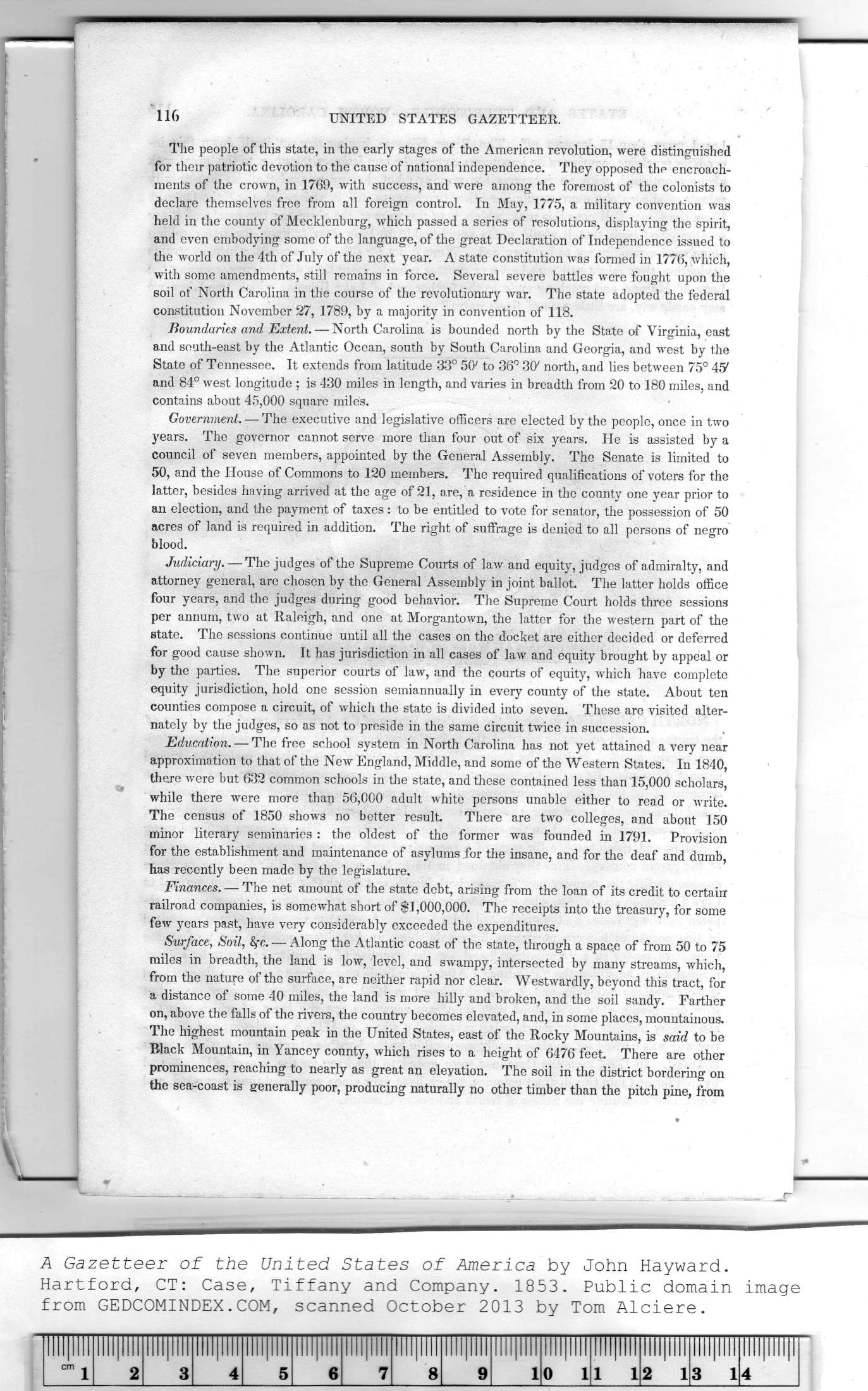|
|
Note: Ctrl and + increases the font size of the text below, Ctrl and - decreases it, and Ctrl and 0 resets it to default size.
116 UNITED STATES GAZETTEER.
The people of this state, in the early stages of the American revolution, were distinguished
for their patriotic devotion to the cause of national independence. They opposed the encroach-
ments of the crown, in 1769, with success, and were among the foremost of the colonists to
declare themselves free from all foreign control. In May, 1775, a military convention was
held in the county of Mecklenburg, which passed a series of resolutions, displaying the spirit,
and even embodying some of the language, of the great Declaration of Independence issued to
the world on the 4th of July of the next year. A state constitution was formed in 1776, which,
with some amendments, still remains in force. Several severe battles were fought upon the
soil of North Carolina in the course of the revolutionary war. The state adopted the federal
constitution November 27, 1789, by a majority in convention of 118.
Boundaries and Extent. — North Carolina is bounded north by the State of Virginia, east
and south-east by the Atlantic Ocean, south by South Carolina and Georgia, and west by the
State of Tennessee. It extends from latitude 33° 50' to 36° 30' north, and lies between 75° 4.V
and 84° west longitude ; is 430 miles in length, and varies in breadth from 20 to 180 miles, and
contains about 45,000 square miles.
Government. — The executive and legislative officers are elected by the people, once in two
years. The governor cannot serve more than four out of six years. He is assisted by a
council of seven members, appointed by the General Assembly. The Senate is limited to
50, and the House of Commons to 120 members. The required qualifications of voters for the
latter, besides having arrived at the age of 21, are, a residence in the county one year prior to
an election, and the payment of taxes : to be entitled to vote for senator, the possession of 50
acres of land is required in addition. The right of suffrage is denied to all persons of negro
blood.
Judiciary. — The judges of the Supreme Courts of law and equity, judges of admiralty, and
attorney general, are chosen by the General Assembly in joint ballot. The latter holds office
four years, and the judges during good behavior. The Supreme Court holds three sessions
per annum, two at Raleigh, and one at Morgantown, the latter for the western part of the
state. The sessions continue until all the cases on the docket are either decided or deferred
for good cause shown. It has jurisdiction in all cases of law and equity brought by appeal or
by the parties. The superior courts of law, and the courts of equity, which have complete
equity jurisdiction, hold one session semiannually in every county of the state. About ten
counties compose a circuit, of which the state is divided into seven. These are visited alter-
nately by the judges, so as not to preside in the same circuit twice in succession.
Education. — The free school system in North Carolina has not yet attained a very near
approximation to that of the New England, Middle, and some of the Western States. In 1840,
there were but 632 common schools in the state, and these contained less than 15,000 scholars,
while there were more than 56,000 adult white persons unable either to read or write.
The census of 1850 shows no better result. There are two colleges, and about 150
minor literary seminaries : the oldest of the former was founded in 1791. Provision
for the establishment and maintenance of asylums for the insane, and for the deaf and dumb,
has recently been made by the legislature.
Finances. — The net amount of the state debt, arising from the loan of its credit to certain
railroad companies, is somewhat short of $1,000,000. The receipts into the treasury, for some
few years past, have very considerably exceeded the expenditures.
Surface, Soil, fyc. — Along the Atlantic coast of the state, through a spac.e of from 50 to 75
miles in breadth, the land is low, level, and swampy, intersected by many streams, which,
from the nature of the surface, are neither rapid nor clear. Westwardly, beyond this tract, for
a distance of some 40 miles, the land is more hilly and broken, and the soil sandy. Farther
on, above the falls of the rivers, the country becomes elevated, and, in some places, mountainous.
The highest mountain peak in the United States, east of the Rocky Mountains, is said to be
Black Mountain, in Yancey county, which rises to a height of 6476 feet. There are other
prominences, reaching to nearly as great an elevation. The soil in the district bordering on
the sea-coast is generally poor, producing naturally no other timber than the pitch pine, from
|
Ili!|llll |
Illllllll |
Illllllll |
Illllllll |
llll|llll |
llll|llll |
llll|llll |
Illllllll |
llll|llll |
Illllllll |
Illllllll |
Illllllll |
Illllllll |
Illllllll |
|
|
cm j |
2 |
3 |
4 |
5 |
6 |
7 |
8 |
9 |
1 |
0 1 |
1 1 |
2 1 |
3 1 |
4 |
|
